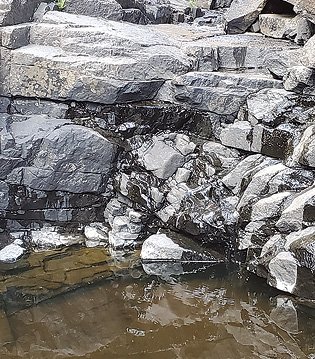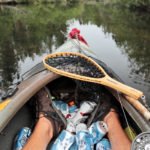GRAND MARAIS—Drought conditions have reduced the flows of many North Shore streams to just a trickle. Northern Wilds reached out to Grand Marais area fisheries manager Steve Persons to learn how low flows affect the brook trout and other fish living in those streams. Below is his response.
Droughts like this test the resilience of our streams in several ways, and outcomes will vary. However, common effects are loss of habitat and connectivity. Fish are squeezed into smaller and smaller spaces. Shallow riffles that are major sources of food production dry out, so the fish packed into the deeper pools are competing for a very limited food supply. With very low water, the ability of fish to reach another refuge, with deeper water, or colder water, or both, becomes very limited. If areas where flow is stagnant, and waters are exposed to direct sunlight, water temperatures can become high enough to be very stressful, or lethal. In extreme cases, fish can become stranded as their pools dry up.
If we go into the fall with low water, trout may not be able to reach spawning sites, and those sites may lack the upwelling water that brook trout, at least, rely on for spawning and egg incubation. With very low flows, we could see bars at the mouths of many of our streams blocking movement of fall-spawning salmon and coaster brook trout into the streams from Lake Superior.
The streams better able to hold fish through a prolonged drought are those with some deeper water, and with good shading (forest cover) or some groundwater input to keep those waters cool. Streams with a lot of intact wetland in their watershed are more likely to maintain enough base flow to support fish. Paradoxically, when water levels in the streams get down to or below base-flow levels, they may actually stay quite cool if shaded, because the little flow remaining comes mainly from cool or cold sub-surface sources. So, for example, although recently the upper Cascade River was quite low, its waters, which can get quite warm in a normal year, were some of the coolest we’ve seen there in mid-summer. That’s one reason why maintaining intact forest cover along our streams has been one of our highest priorities.
As bad as a summer drought can be, particularly in smaller streams, effects could be worse if we go into the winter with low flows (and little snow). In small streams those conditions allow anchor ice to form on the bottom as cold seeps in under the bed, and streams can freeze entirely, from the bottom up. That can result in the complete loss of fish in the stream, or at least a great reduction in numbers that can take years to recover from. Several small trout streams in this area lost their trout in the severe 1976-77 drought, and never recovered. Several more area streams were affected by anchor ice in the early 2000s, when fall water levels were very low, the early winter was very cold, and little snow fell.
Best case scenario for ending this drought will be a shift in weather patterns that brings us some prolonged periods of rain. Enough to recharge our wetlands and fill our streams, but not enough (at one time) to bring in a large surge of warm water, or to wash in a load of sediment from eroding banks and exposed soils.—Steve Persons, Area Fisheries Supervisor






